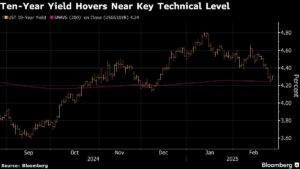Treasury Yields on the Decline: Understanding Economic Pressures and Market Reactions
In recent trading sessions, U.S. government bond yields have dropped, revealing a complex interplay between economic signals and market psychology. On Thursday, Treasury yields rebounded slightly but remained close to historical lows amid a blend of unsettling economic data and comments from President Donald Trump regarding impending tariffs.
Economic Indicators and Market Reactions
The latest economic data points suggest a more fragile growth outlook. Following upward revisions to price metrics in the fourth-quarter GDP report and an unexpected surge in jobless claims—hitting 242,000—investors are grappling with uncertainty. This situation has driven the Treasury market, which has seen a rally for six consecutive sessions primarily due to weaker-than-anticipated economic data. The interaction of these forces has led to an increase in Treasury yields by about three basis points, although they remain approximately 30 basis points below their peaks earlier in February.
Strategists like Evelyne Gomez-Liechti from Mizuno International remark that the markets appeared unprepared for recent macroeconomic weaknesses, leading to heightened volatility as evidenced by the ICE BofA MOVE Index, which has reached a six-week high.
Trade Policies and Growth Concerns
Trump’s announcement of tariff implementations against imports from Mexico, Canada, and China scheduled for March 4 has introduced additional complexity into the market landscape. As confusion mounts over the potential effects of these tariffs, many investors believe the Federal Reserve may pivot from focusing solely on inflation to addressing mounting economic weaknesses. Current projections among traders now include expectations for two quarter-point interest rate cuts later this year—an indication of growing concern over economic stagnation.
Although we may not yet be amidst a full-fledged "growth scare," according to Brian Quigley of Vanguard, there are early signs that could indicate a worrying trend if economic conditions continue to deteriorate. For example, the 10-year Treasury yield, which peaked at 4.8% back in mid-January, has now dropped to around 4.25%, a key level that might define its future trajectory.
Navigating the Uncertain Waters Ahead
With market analysts noting that factors like consumer sentiment, retail sales, and consumer confidence are influencing lower yields this month, navigating these choppy waters requires both strategic foresight and a keen analysis of incoming economic data. Investors will be watching closely as the first major datasets for February—including the employment report—are set for release next week.
Apollo Global Management’s Torsten Slok illustrated the potential trajectory of Fed policy, suggesting that should economic growth continue to falter or unemployment rates rise, the Fed will have little choice but to consider growth risks more seriously. On the flip side, persistent inflationary pressures in labor and goods markets may demand that interest rates remain elevated for an extended period.
The Tug of War: Inflation vs. Growth
As financial analysts point out, markets face a "tug of war" between the inflationary risks arising from changes in U.S. administration policies and the possible negative impacts of these policies on economic growth. Laura Cooper from Nuveen encapsulated this sentiment, highlighting the volatility in prices as markets attempt to digest the incoming data against the backdrop of policy developments.
Investors are encouraged to remain vigilant and adaptable as they track these evolving trends—recognizing that while the headlines may signal caution, there are still opportunities to be found in strategic positioning.
Conclusion: Stay Informed and Engaged
In an environment where economic signals fluctuate rapidly, staying informed and engaged with the latest financial insights is crucial. The current dynamics in the bond market illustrate just how intertwined economic data, government policy, and market psychology can be. By keeping a close watch on these factors, investors can better navigate the challenges ahead and identify potential opportunities that arise from this intricate landscape.
For more in-depth analysis and insights tailored to the needs of proactive investors, stay connected with Extreme Investor Network as we continue to monitor these developments and their implications for the investment community.

